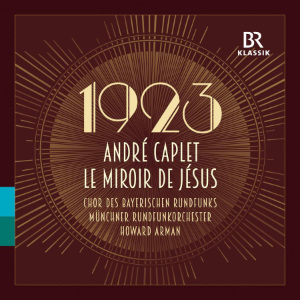
André Caplet (1878-1925)
Le Miroir de Jésus: Mystères du rosaire (1923)
Anke Vondung (mezzo-soprano)
Choir of Bavarian Radio
Munich Radio Orchestra/Howard Arman
rec. live, April 2019, Herz-Jesu-Kirche, Munich
Libretti in French, German and English
BR Klassik 900342 [60]
Le Miroir de Jésus was André Caplet’s last major completed work, composed two years before his early death at the age of 46. It’s based on poems by Henri Ghéon that focus on pivotal incidents in the life of Jesus, as seen from the perspective of the Virgin Mary. Caplet subtitled his work Mystères du rosaire and cast it in three parts, each subdivided into six brief movements of which the opening is an instrumental prelude. The fifteen poems are sung by mezzo Anke Vondung with the accompaniment of a female chorus, strings and harp.
The trajectory of the work, Christ’s birth, Passion, Crucifixion and Resurrection – Joy, Suffering, and Glory – is charted with sublime refinement. Howard Arman paces each section with the surest of touches and the most refined of gestures, ensuring that the Prelude to the First Part fuses diaphanous Debussy-inspired writing with richer-toned expressive lines for the strings that are evocative, ardent and profoundly spiritual. Caplet’s writing is precise and considered, and his accomplished use of melancholic presentiment – as in the Nativité of the First Part – possesses a simplicity, and yet a directness, that proves consistently compelling. His handling of what are deliberately reduced orchestral forces of strings and a harp reveals a master orchestrator. Incidents such as the rippling water evocations in the Présentation simply reinforce his command of impressionist-derived devices put to his own use.
Arman and the Munich Radio Orchestra catch the spare unisons in Part Two’s Prélude and they expand density over the final bars the better to explore the Gregorian implications of the succeeding Agonie au Jardin. Over this section one encounters reflective lyricism and much beauty as well as terse, jagged writing in the scene where Christ is crowned with thorns. Christ’s carrying of the cross is searing though this heightened sonic density soon thins to individual string voices, where Caplet comes closest to Schoenberg in his espousal of sprechgesang.
The richness and variety of his imagination is palpable throughout and in the Prélude to Part Three Arman ensures that Caplet’s presaging of elements of minimalism is clear even as Caplet generates a halo-like subtlety after the Resurrection scene. The spiritual intensity reaches a transcendence and moving intensity, the women of the choir of Bavarian Radio exuding exultant echo effects as the work draws to a close, Vondung both speaking and then singing rapturously with choral support.
The performance is beautifully balanced and is taken from a live performance in the Herz-Jesu-Kirche, Munich – not that one would know it’s live, as there’s no audience noise audible. Vondung is a splendid exponent, as she has proved in Baroque Passions and cantatas on disc, whose mezzo provides a sympathetic and rich-voiced conduit both for Ghéon’s texts and for Caplet’s richly varied, spiritually charged music. Whether solo or with the chorus, whether in speech or in controlled declamation, she is a near-ideal guide. Arman paces the work perfectly drawing out its radiance as well as its ethereal beauties, and – occasionally – its more harmonically astringent elements.
There’s a good booklet and full texts are provided in French with German and English translations.
There’s a 1953 French radio broadcast available (review) and a Marco Polo release on 8.225043 (review), neither of which I’ve heard. Arman and his forces however reinforce this work’s status as a compelling liturgical masterpiece – a work of quiet but refined beauty.
Jonathan Woolf
Help us financially by purchasing from





















